
Frequently Asked Questions
Adopt a Storm Drain
Waste:
- Pick up and dispose of pet waste properly.
- Do not leave bagged poop on trails. During rain events it will flow directly to nearest waterway.
- Do not put leaves, cut grass, and other yard waste in or near storms drains.
Vehicles:
- Fix vehicle leaks
- Dispose of used motor oil and other car fluids at your local service station or the Household Hazardous Waste Facility (512)974 -4343
- Wash your vehicle where soap and water flows into grass, not the street, or use a carwash.
Lawns:
- Use fewer fertilizers, pesticides, and weed killers in your yard
- Plant native plants that will not need as much water and fertilizers.
Trash:
Start a fun habit of picking up 3 pieces of trash per day. 75% of trash in waterways came from land. Large trash can block storm drains causing flooding. For removal of bulky trash call 3-1-1.
- Storm Drain Marking Volunteer Program
- Scoop the Poop Education
- Adopt A Creek https://keepaustinbeautiful.org/programs/adopt-a-creek/
- Sign up to receive a once a month email about volunteer opportunities in building Rainscapes, Grow Zones, Invasive Plants removal, and/or collecting aquatic macroinvertebrates here
- Report Pollution and Dumping to our Pollution Prevention Hotline (512)974-2550
Available anytime 24 hours a day 7 days a week
Austin Invasive Plants Management
The Austin City Council passed a resolution on April 8, 2010 directing the City Manager to develop an Invasive Species Management Plan to guide efforts to minimize the harmful environmental and economic impacts of invasive plant species on city-managed properties. Subsequent to that resolution an agreement with the Lady Bird Johnson Wildflower Center led to creation of a working group with representatives from several City departments, Austin Parks Foundation, Keep Austin Beautiful, Texas Parks and Wildlife and the Austin Invasive Species Coalition. Over the course of ten consensus-based meetings, the Working Group developed strategic five-year goals based on a central framework of prevention, early detection-rapid response and long-term control at prioritized sites. The plan also includes recommendations for implementation including staffing, funding sources, centralized mapping and monitoring, and education and outreach. To improve the plan’s success, the working group has developed a preliminary list of priority invasive species and an invasive species resource manual with identification fact sheets and best management practices to control priority species.
The City of Austin Invasive Species Management Plan was developed in collaboration with multiple non-profits and departments.
Austin Energy
Austin Invasive Species Coalition – represented by American Youthworks Environmental Corps
Austin Parks Foundation
Austin Water Utility
Keep Austin Beautiful
Lady Bird Johnson Wildflower Center
Parks and Recreation Department
Planning and Development Review
Texas Parks & Wildlife
Watershed Protection Department
When a species ends up in a new ecosystem, it is considered "introduced". Often, invasive species are spread by humans who do not realize that these plants, animals and insects are highly destructive.
This may happen, for example, when people plant garden ornamentals, range forage plants for cattle, or plants used for erosion control and habitat enhancement for wildlife. This can also occur when animals and insects are introduced to be used to control other organisms (particularly in agriculture).
Other species are introduced accidentally on imported nursery stock, fruits, and in ship ballast waters, on vehicles, in packing materials and shipping containers, through human-built canals, and from human travel. Dumping aquarium exotic fish and unwanted exotics into the water or wild are other common ways invasive species spread.
Drainage Charge
The impervious cover data is generated using aerial photography collected every two years. Each pixel on the aerial photography represents 6 inches on the ground. The accuracy is suitable for defining the edges of buildings, patios, driveways and other types of impervious cover. This data was used to create impervious cover maps seen on the Find My Drainage Charge Map Tool. (For best results, use Internet Explorer 9 or higher, Firefox, Google Chrome or Safari.)
For properties developed or modified after the latest aerial photography, we use building permit data. Bills are typically adjusted based on the latest aerial photography in February during odd-numbered years.
The following information pertains specifically to the calculation and application of impervious cover for determining the drainage charge imposed by the City of Austin's Watershed Protection Department.
Impervious cover is any type of human-made surface that doesn’t absorb rainfall, including:
- Rooftops
- Patios
- Driveways, paved and unpaved
- Sidewalks
- Roadways
- Parking lots, paved and unpaved
- Some decks
Uncovered wooden decks and unpaved portions of driveways count as 50% impervious cover. If you have these features, we may be able to lower the impervious cover on your account, which will in turn lower your bill. Please call 512-494-9400 and ask about an administrative review of your drainage charge.
A more complete definition of impervious cover is found in Section 25-8-63 of the Austin City Code. While impervious cover has broader implications in terms of urban planning and land development regulations, this information focuses on its connection to the drainage charge. For more comprehensive information about impervious cover regulations beyond the drainage charge, please refer to the appropriate resources and guidelines provided by the City's Development Services Department.
The stormwater drainage charge is shown on your monthly utility bill in the Drainage Service section. It funds the City of Austin's drainage utility mission and is authorized by the Texas Local Government Code.
The drainage charge was first adopted in 1982, the year after the 1981 Memorial Day Flood, which killed 13 people and caused $35.5 million in damage.
The drainage charge pays for a wide variety of programs to help with flooding, erosion and water pollution across Austin. Many projects and programs are working quietly behind the scenes to protect lives, property and the environment. Crews clean trash and debris from Lady Bird Lake, maintain our drainage infrastructure, and respond to more than 3,000 service requests annually. Staff respond to the pollution hotline about environmental spills and emergencies 24-hours a day. They coordinate numerous projects to help reduce the risk of flooding and erosion. Many of the programs, services and projects listed on the Watershed Protection Department web site are funded in whole or in part by the drainage charge and would not be possible without the charge.
Some projects that are funded entirely or in part by the drainage charge include:
- ATXfloods and closing of flooded low water crossings
- Restoration of the Shoal Creek Peninsula along Lady Bird Lake
- Boggy Creek Greenbelt Streambank Restoration
- Combating hydrilla on Lake Austin
- Buyouts of flood-prone properties
Earth Camp
No, only Title I schools in the Austin Independent School District are eligible.
AISD 5th grade teachers that have been trained and attended a week of Earth Camp led by City staff may participate in Teacher-Led Earth Camp! To schedule, please email our Earth Camp coordinator.
The four Earth Camp Field Guides are available below for you to download. They require Adobe Acrobat Reader for viewing. If you are scheduled for Teacher-Led Earth Camp, an Assistant will bring the field trip materials. If you would like to purchase materials, reference the "Materials" PDF file.
Field Trip Guide Contents * required when leading Teacher-Led Earth Camp
Edwards Aquifer/Barton Springs
- * Sinkhole Lesson
- *Karst Watering Holes Lesson (420 kb)
- Cave PowerPoint Lesson (42 kb)
- Cave PowerPoint Presentation
Barton Springs
- * Barton Springs Tour Lesson (210 kb)
- * Tour Map
- * Splash! Exhibit Lesson (111 kb)
Scavenger Hunt *only print the Lesson for the Park you will visit
All Parks Scavenger Hunt Lesson
- Blunn Creek Game Sheet - English (557 kb)
- Blunn Creek Game Sheet - Spanish (528 kb)
- Blunn Creek Trail Map (522 kb)
- Bull Creek Game Sheet - English (485 kb)
- Bull Creek Game Sheet - Spanish (479 kb)
- Bull Creek Trail Map (4 mb)
- Walnut Creek Game Sheet - English (671 kb)
- Walnut Creek Game Sheet - Spanish (567 kb)
- Walnut Creek Trail Map (146 kb)
- Slaughter Creek Game Sheet - English (515 kb)
- Slaughter Creek Game Sheet - Spanish (510 kb)
- Slaughter Creek Trail Map (510 kb)
- Colorado River Game Sheet - English (649 kb)
- Colorado River Game Sheet - Spanish (561 kb)
- Colorado River Trail Map (3.2 mb)
- Creek Observation Data Sheet (146 kb)
- Flowers (3.8 mb)
- Ammonite (407 kb)
Green Classroom
- * Watershed Pollution Activity Lesson (173 kb)
- * Nine Square Puzzle Lesson (191 kb)
- * Soak In Run Off Lesson (181 kb)
- Green Gardening Lesson (194 kb)
Macroinvertebrate Activities
- Macroinvertebrate Test Lesson (997 kb)
- Bug Pollution Test-English (2.25 mb)
- Bug Pollution Test-Spanish (2.25 mb)
- Aquatic Bug Game (26kb)
Earth School
The Earth School presentation is typically one hour and 3o minutes per class (however, special accommodations may be made for a longer or shorter presentation). The more time we have scheduled with your students, the more in-depth educational opportunities we can provide.
Teacher Testimonials:
“I LOVE that the lessons are outside. It was nice to incorporate our school grounds and our watershed into the lessons.”
“Great presentations! The kids learned A LOT and had a blast doing it.”
“This is a very valuable lesson for the students. I love the hands-on activities. Students are engaged and work together to discover the knowledge. It ties in well with concepts taught in class. The presenter was wonderful. The students truly enjoyed the lesson.”
“Not only was the information relevant to the curriculum, but it was relevant to the lives of the scholars.”
“I loved all of the interactive activities. The kids were 100% engaged.”
If your school is not able to schedule all of the presentations in one day, you can schedule two consecutive days.
An Earth School teacher will bring all of the materials that students need. If you regularly incorporate an interactive science notebook into your classroom routine, you may wish to have students arrive to the presentation with their journals.
Registration forms are accepted throughout the school year, but the earlier you register the more likely you are to receive your choice dates.
Environmental Integrity Index
We have developed a watershed viewer, so it is easy to find out what watershed you live in and to find out its Environmental Integrity Index score.
Erosion Control and Stream Restoration
Rock riprap is a layer of loose rock used to protect soil from the erosive or scouring flows of water. Rock riprap is sometimes used for bank protection or bed stabilization in stream restoration projects where other erosion control techniques are not appropriate.
In order for the rock riprap to properly function, installing rock of good quality and the proper size gradation is important. Design criteria for rock riprap are listed in the Environmental Criteria Manual (ECM) Section 1.4.6. Rock riprap materials and construction methods are described in City of Austin Standard Specification 591S.
The Watershed Protection Department recommends a field gradation test method for use during construction projects to verify that the specified rock will be installed. The gradation test method is described in the following documents, and an example analysis worksheet is provided. However, engineers may use an alternate preferred method conforming to ECM Section 1.4.6.
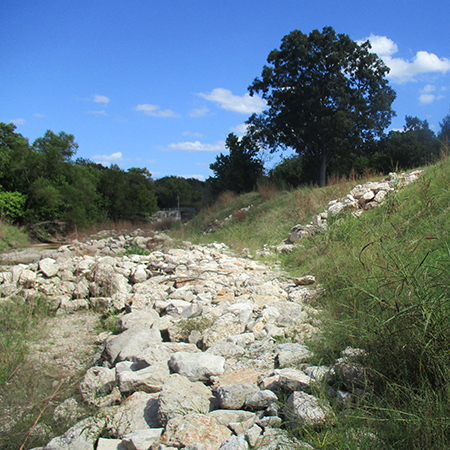
Family Clean Creek Camp
No, we cannot accommodate younger children.
Yes, there is a high demand to attend camp so please be committed to attending the full week.
Various sites around Austin. Refer to directions.
Groundwater
Groundwater tracing is a commonly used technique to understand water movement through karst aquifers like the Edwards. The dissolution of limestone occurs slowly over a long period of time and these opening are pathways or conduits for water to enter the aquifer and for groundwater to move through the aquifer. Tracing can use naturally occurring chemical in the water, introduced chemicals or dyes to track water movement. A tracer is typically introduced into the aquifer through a naturally occurring recharge feature and wells, springs and other water ways are monitored to detect the tracer.
A coordinated tracing program began in the Barton Springs Edwards Aquifer in 1996. Since that time, over 30 traces have been conducted. A special project began in 1996 in conjunction with the Barton Springs/Edwards Aquifer Conservation District (BS/EACD) called the Barton Springs Zone Dye Trace Study. Dye was injected into caves and sinkholes to map water movement in this segment. The goals were to trace the water going into the aquifer at various points in the recharge zone, measure flow rates, and determine which wells and springs the water would emerge from. Travel rates from recharge points to springs varied from 4 miles/day to 0.25 miles/day. Onion Creek is the largest contributor of the watersheds to Barton Springs under normal conditions, but a 2017 study shows that the Blanco River can be a significant source of recharge during drought conditions.
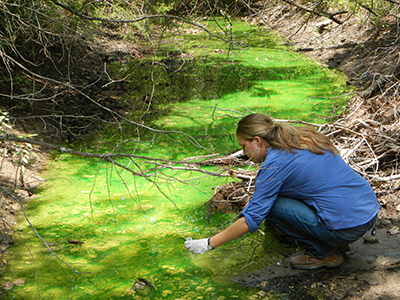
Hydrilla
- To minimize fragmentation and spreading of plants, avoid boating through dense hydrilla mats.
- Remove hydrilla from your boat's propeller and trailer before and after boating.
- Dispose of all plant fragments on shore: Because new plants can sprout from fragments, all plant material cut or collected MUST be removed from the lake. Throwing hydrilla back in the lake can result in a maximum fine of $2000 per plant.
- Follow City of Austin hydrilla disposal guidelines:
- Plants should be placed as far up on the shore as possible.
- Plant material stockpiled within 75' of the water's edge should be surrounded on the downslope side by silt fencing.
- Plant material pulled from the lake will contain small fish and other organisms, and will have an odor associated with it. The plants are mostly water, and piles will lose 90% of their bulk within 2-4 weeks. This material can be used to mulch flowerbeds or gardens.
- Learn more about Friends of Lake Austin (FOLA) - a citizen group dedicated to preserving and enhancing Lake Austin for those who live, work and play on the lake. They have been working to help fight the hydrilla infestation on Lake Austin and are taking an active role in the approved management plan
Hydrofiles
Contact Sara Heilman email or phone 512-974-3540. Our training kit contains 6 sets of the following kits: Dissolved oxygen, pH, TDS, nitrate, and E. coli. The kit may be checked out and we provide training for your students if required. You may also request one free complete test kit.
Water test kits are available for teachers and classes for educational use. General use kits may be requested through Keep Austin Beautiful
Salamanders
Barton Springs Pool – Parthenia Spring
Parthenia Spring, the fourth largest spring in Texas, is fed by the Edwards Aquifer and discharges as part of Barton Creek. Before western colonization of the area, the Native Americans used the springs as healing grounds. Until it burned down at the end of the 19th century, a flour mill utilized part of the spring-fed creek. In 1917, Barton Spring was designated a city park. At the time, only manmade rock dams were built to create a pool for swimming, and after every flood, the dam would have to be rebuilt. In 1929, a permanent lower concrete dam was constructed, and the upper concrete dam followed only three years later creating Barton Springs Pool. A concrete tunnel beneath the north sidewalk of the pool bypasses all creek water from upstream of the pool (except during flood events), discharging the creek water into Barton Creek downstream of the lower pool dam. Although Barton Springs Salamanders inhabit Barton Springs Pool, it is open to the public year round with little to no human disturbance to the salamanders or their habitat.
Individual salamanders are usually observed around the main spring outflows, hidden within a 1 to 6" deep zone of gravel and cobble overlying a coarse sandy or bare limestone substrate. These areas are noticeably clear of fine silt or decomposed organic debris and appear to be kept clean by the briskly flowing spring water. Salamanders are also occasionally found around minor spring outlets within the limestone fissures.
In the late 1800’s, Old Mill Spring, also known as Zenobia Spring, was developed as a grist mill, and as a gathering place. The National Youth Administration began a project building a Sunken Garden surrounding Old Mill Spring in 1938. Rock walls were built around the spring and stone terraced steps were constructed within the spring leading out of the spring pool.
Upper Barton Spring is located upstream of Barton Springs Pool and is the only Barton Springs Salamander locality that is unaltered. It is an ephemeral spring that stops flowing when Barton Springs discharge is about 40 cubic feet/second. The salamanders retreat with the water level and are thought to live within the aquifer until the spring begins to flow again.
Scoop the Poop
Yes – by City Ordinances, animal owners and handlers must pick up after pets.
§ 3-4-6 DEFECATION BY A DOG OR CAT. "An owner or handler shall promptly remove and sanitarily dispose of feces left on public or private property by a dog or cat being handled by the person, other than property owned by the owner or handler of the dog or cat.” Potential fine: Up to $500.
§ 15-6-112 - ACCUMULATIONS AND DEPOSIT OF WASTE PROHIBITED. (A) A person commits an offense if the person deposits, causes to be deposited, or permits to accumulate any dry or wet solid waste upon any public or private premises within the city in such a manner as to emit noxious or offensive odors or to become unsanitary or injurious to public health or safety.
§ 3-2-11 - ENCLOSURE REQUIRED. (A)(3) maintained in a sanitary condition that does not allow flies to breed or cause an odor offensive to an adjacent residence or business
Stormwater Management
Using physical and biological treatment mechanisms, biofiltration uses an organic filtration media with vegetation to remove pollutants. As with sedimentation/filtration systems, runoff is first diverted into a sedimentation basin, where particulate pollutants are removed via gravity settling. This is followed by filtration through an 18" layer of vegetated media.
Biofiltration systems are considered to provide a level of treatment equivalent to sedimentation/filtration, and also provide extended detention that enhances baseflow and reduces stream erosion. Biofiltration systems are not allowed in Barton Springs Zone (BSZ) watersheds as a stand-alone water quality control, as they are not capable of achieving a non-degradation level of treatment.
Because of the vegetation, biofiltration systems can be aesthetic amenities and may be eligible for landscape credit (unlike sedimentation/filtration systems). To ensure proper management of the pond system, filtration media, and vegetation, an Integrated Pest Management (IPM) Plan is required.
The current design criteria is similar to that for sedimentation/filtration systems, and two design alternatives are available. In “full” sedimentation/filtration systems the entire water quality volume is held in the sedimentation basin, which then slowly discharges runoff to the filtration basin via a perforated riser pipe. The alternative “partial” sedimentation/filtration design foregoes the perforated riser pipe, and distributes the water quality volume between the filtration basin and a sediment chamber, the latter separated from the filtration bed by a vegetated hedgerow. The “full” design is required when the City of Austin is responsible for maintenance.
Design guidelines for biofiltration can be found in Section 1.6.7.C of the Environmental Criteria Manual. For information on the biofiltration media, go to biofiltration media guidance. Also available is a list of potential suppliers.

Below is a list Biofiltration Media Suppliers that we are aware of.
Organics "By Gosh"
Sherry Williams
Wholesale Bulk
Account Executive
512-872-1434
Organics "By Gosh"
2040 FM 969
Elgin, TX 78621
sherry@organicsbygosh.com
- Non-Structural Controls are Best Management Practices (BMPs) that do not involve a structured, or engineered solution. They include such measures as education, site planning, and stormwater management regulations. Because it is usually easier and more effective to prevent pollution before it occurs, non structural BMPs are very cost-effective. These measures limit or eliminate pollutants before they end up in the stormwater.
- Non-structural controls include: non-required vegetation, vegetated filter disconnect, integrated pest management, and regulations.
Porous Pavement includes a load-bearing, durable concrete surface together with an underlying layered structure that temporarily stores water prior to infiltration. Porous Pavement is a water quality control best management practice (BMP) using the storage within the underlying structure or sub-base to provide groundwater recharge and to reduce pollutants in stormwater runoff.
To ensure proper functioning of porous pavement, no off-site runoff is allowed and proper subgrade conditions must exist.
Porous pavement is currently only allowed for pedestrian use and not for parking lots, stormwater hot spots, or areas where land use or activities generate highly contaminated runoff. Since porous pavement is an infiltration practice, it should not be applied at stormwater hot spots due to the potential for ground water contamination.
Environmental Criteria Manual 1.6.7.E of the Environmental Criteria Manual
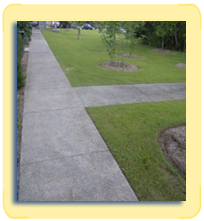
Rooftops can generate large volumes of runoff which, when discharged to paved surfaces and landscaped areas, can generate large pollutant loads. Rainwater harvesting systems can capture this runoff before it is discharged, thus preventing pollution while also putting the captured water to beneficial use, such as landscape irrigation or cooling water.
Rainwater harvesting is eligible for water quality credit only for commercial development. The amount of credit will depend on the size (water quality volume) and drawdown time of the system. Rainwater harvesting systems can provide equivalent treatment to a sedimentation/filtration system, or be designed to meet a non-degradation level of treatment required in Barton Springs Zone watersheds. An Integrated Pest Management (IPM) Plan is required if the captured rainwater is applied to vegetation.
Design guidelines for rainwater harvesting can be found in Section 1.6.7.D of the Environmental Criteria Manual.
The Water Conservation staff of the City of Austin Water Utility is available to provide input on how to achieve cost-efficient design and equipment selection that will also help reduce water and wastewater costs.

Under the SOS regulations, certain watersheds in Austin allow no increase in pollutant load to receiving streams. Retention irrigation ponds capture stormwater in a holding pond and use the captured volume for irrigation of the surrounding landscaped areas rather than allowing direct release to receiving streams. There is virtually no discharge of runoff off-site and it mimics the undeveloped watershed conditions by allowing infiltration of smaller rainfalls. Retention irrigation systems have excellent pollutant removal efficiency.
Environmental Criteria Manual 1.6.9 (Guidance for Compliance with Technical Requirements of the SOS Ordinance)
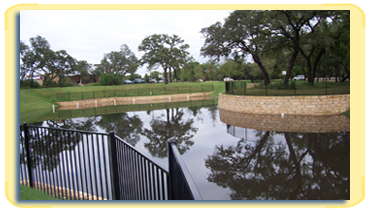
Sedimentation/Filtration systems are the primary stormwater treatment device used in Austin. Runoff is first diverted into a sedimentation basin, where particulate pollutants are removed via gravity settling, followed by filtration through an 18” layer of sand. These systems can achieve removal rates of 40-90% for suspended solids, heavy metals, and organics. Properly operating systems will typically capture 90% or more of all runoff from the contributing drainage area, and release it at a slow rate that enhances baseflow and reduces stream erosion.
Sedimentation/filtration systems are not allowed in Barton Springs Zone (BSZ)watersheds as a stand-alone water quality control, as they are not capable of achieving a non-degradation level of treatment.
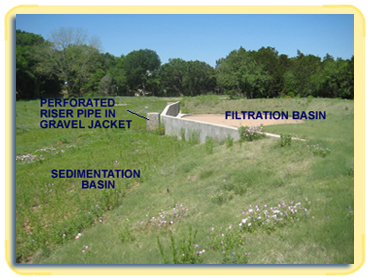
Two design variations are allowed in Austin. In “full” sedimentation/filtration systems the entire water quality volume is held in the sedimentation basin, which then slowly discharges runoff to the filtration basin via a perforated riser pipe. The alternative “partial” sedimentation/filtration design foregoes the perforated riser pipe, and distributes the water quality volume between the filtration basin and a sediment chamber. The latter is then separated from the filtration bed by a gabion wall or other porous structure. The “full” design is required when the City of Austin is responsible for maintenance.

Design guidelines for full and partial sedimentation/filtration ponds are provided in Section 1.6.5.of the Environmental Criteria Manual (see 1.6.5.A for “full” systems and 1.6.5.B for “partial” systems).
A vegetative filter strip is an innovative water quality control in which runoff is routed as sheet flow through a mildly sloped, well-vegetated area, thus promoting infiltration, sediment deposition, and filtration of pollutants. Because of the need to maintain sheet flow, filter strips are typically used to treat small drainage areas, or areas with low impervious cover. These treatment systems can be used in both Barton Springs Zone (BSZ) and non-BSZ watersheds, but those in BSZ watersheds must be larger. To maintain the proper functioning of these systems the vegetation must not be cut too short (minimum 3” for turfgrass and 18” for bunchgrass), grass clippings must be removed out of the filter strip, and an Integrated Pest Management (IPM) plan is required. Design guidelines for vegetated filter strips are provided in the Environmental Criteria Manual (Section 1.6.7 Alternative Water Quality Controls)

